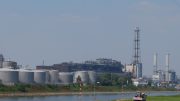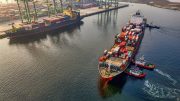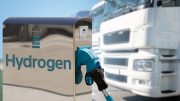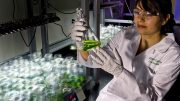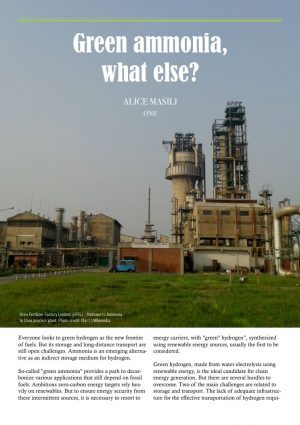 Everyone looks to green hydrogen as the new frontier of fuels. But its storage and long-distance transport are still open challenges. Ammonia is an emerging alternative as an indirect storage medium for hydrogen.
Everyone looks to green hydrogen as the new frontier of fuels. But its storage and long-distance transport are still open challenges. Ammonia is an emerging alternative as an indirect storage medium for hydrogen.
So-called “green ammonia” provides a path to decarbonize various applications that still depend on fossil fuels. Ambitious zero-carbon energy targets rely heavily on renewables. But to ensure energy security from these intermittent sources, it is necessary to resort to energy carriers, with “green” hydrogen”, synthesized using renewable energy sources, usually the first to be considered.
Green hydrogen, made from water electrolysis using renewable energy, is the ideal candidate for clean energy generation. But there are several hurdles to overcome. Two of the main challenges are related to storage and transport. The lack of adequate infrastructure for the effective transportation of hydrogen requires expensive dedicated networks.
Large-scale storage of the gas, so necessary for the progression towards a hydrogen economy, also has severe limitations — the need for specially insulated cryogenic tanks and refrigeration units greatly increases weight and cost. The chemical conversion of hydrogen into another energy carrier can provide a solution.
Ammonia has a high hydrogen content and does not contain carbon. Obtained by the reaction of atmospheric nitrogen with hydrogen, it can be easily stored as a liquid at moderate pressures (10-15 bar) or refrigerated at -33°C. It can be conveyed around the world through the existing distribution network of pipelines, tankers and ships.
Furthermore, it could offer numerous other advantages, even as a zero-carbon fuel, because it can burn in vehicle engines or in power plants to generate electricity. When ammonia is produced from green hydrogen – making it “green ammonia” – these benefits have a significant impact.
However, ammonia has its limitations too. It is a toxic gas that produces nitrogen oxides. When burned at high temperatures, ammonia produces nitrogen dioxide, contributing to air pollution which causes acid rain and can damage respiratory systems.
Combustion also produces small amounts of nitrous oxide, a more harmful greenhouse gas than carbon dioxide and methane. It is therefore preferable to use fuel cells rather than an internal combustion engine; a fuel cell converts chemical energy into electrical energy without burning fuel, thus preventing the release of dangerous gases or particles into the air.
Different types of fuel cells have been studied, and their performance varies according to specific applications. Solid oxide fuel cells (SOFC) are considered the most efficient power generation method. This type of fuel cell shows high energy conversion efficiency and a high degree of fuel flexibility.
A 2-megawatt system, fueled with ammonia, is installed on the Viking Energy supply ship in Norway and will be tested in 2024. There are several challenges to address before the technology can be fully exploited, such as increasing power density and reducing costs.
Several projects for the production of electricity from green ammonia are underway. Some are on a pilot scale. The EU HiPowAR (Highly Efficient Power Production By Green Ammonia Total Oxidation In A Membrane Reactor) project is testing an innovative technology for direct energy conversion of renewable ammonia fuel into electricity through a membrane reactor.
Compared to combustion engines and steam power plants, the new membrane reactor should provide greater energy conversion efficiency. It should also enable a breakthrough in the direct conversion of ammonia as an easily storable, carbon-free hydrogen carrier into usable energy.
Leading fertilizer companies are also actively involved. Fertiberia and Iberdrola have announced their intention to produce green ammonia for emission-free fertilizers. Spain could become one of the most important producers and exporters of green ammonia in Europe.
The initial investment of 150 million euros involves constructing a 100 MW photovoltaic solar field, a lithium-ion battery system with a storage capacity of 20 MWh, and an electrolyzer capable of producing about 360 kg/hour of hydrogen (20 MWel in). The green hydrogen produced will be used in the Puertollano Fertiberia ammonia plant to produce green fertilizers.
The latest fertilizer company to announce a massive green ammonia project is the Norwegian Yara International. To electrify and decarbonize its ammonia plant in Porsgrunn, they will replace the hydrogen from hydrocarbons with water electrolysis powered by renewable energy.
In partnership with Statkraft and Aker Horizons, Yara aims to produce emission-free fuel for shipping, carbon-free fertilizers and ammonia for industrial applications.
It plans to install electrolyzer capacity for 20,000 tons of ammonia per year by 2023. The company also has two other exciting pilot projects in store: one in Pilbara, Australia, with 3,500 tons of ammonia capacity from solar energy; another in Sluiskil, the Netherlands, with 70,000 tons of green ammonia capacity from wind energy.
The futuristic city of Neom in Saudi Arabia will host the largest and most ambitious project. Developed by a joint venture between Neom Town Hall, the Saudi company ACWA Power and the US Company Air Products, the facility will produce 1.2 million tons of green ammonia per year.
Green ammonia is not only a valid alternative to hydrogen as a carbon-free fuel. It can also help hydrogen’s cause. With the correct subsidies, there is a real potential to develop a renewable energy export market to kick-start the hydrogen economy.
Alice Masili


